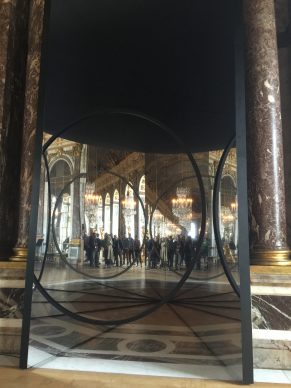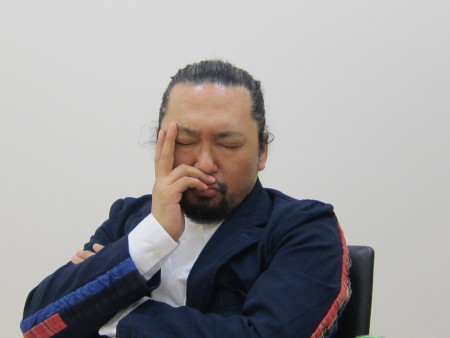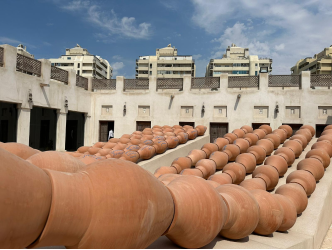Here in France, where people have a new habit of vandalising artworks, the Danish artist Olafur Eliasson arrives to face-off against the opulence of the Sun King but also, alas, against reactionaries of every stripe. Until 30 October he’s taking up residence in Versailles with eight pieces spread across the rooms of the palace as well as in the gardens. He follows in the footsteps of Anish Kapoor who last year created a spectacular series of installations which were scandalously vandalised on three separate occasions. Olafur is wisely choosing to ignore the violence of 2015. ‘2015 is in the past. I am extremely happy to be in Versailles. Attacks on art are not exclusive to France. Throughout history, culture has always been perceived as a rupture with society. In any case, culture is stronger than violence. Could you imagine a cultural system not creating problems?’
Eliasson’s works, scattered around the visitor’s circuit, are almost like whispers in the midst of the baroque décor and the crowds of mass tourism.
Mirrors, optical illusions, a spinning artificial sun…
He says, ‘It’s not a fake sun. It’s just smaller.’
The Dane commands your attention, yet his language is not authoritarian in any way. He speaks to those visitors who prefer to direct their gaze towards the little details and stray from the well-beaten path of the guided tour. At Versailles he retells, on a symbolic level, the court games of Louis XIV, the narcissism, the surveillance, the appearances.
In the galerie des Glaces he has installed a large kaleidoscope, alluding to the pastime so beloved by the nobility from that era where reality is transformed into coloured geometric shapes. If at first glance Eliasson offers something to marvel at, he also offers the possibility of questioning your assumptions. Baroque or not baroque?
In the gardens, his giant waterfall, incorporated into the sublime scheme designed by André Le Nôtre, comes into view from the Palace.
Is it thirty or forty metres high? ‘The scale of its enormity depends on where you look at it from. It is simply the perfect height,’ says the artist evasively.
For a romantic such as myself, it brings to mind a huge diving board to commit suicide from – the suicide of our planet. For his part, the artist is content to observe that the gigantic crane supporting the waterfall is the same colour as the sculptures in Neptune’s pool.
This master in the art of creating stars who uses space as his raw material, Eliasson has a legitimate place at the home of the Sun King.
Olafur works with the intangible, with sensations. This particular desire comes, in all probability, from his childhood in Iceland and from the power that nature expresses there.
‘Icelanders combine a spiritual and a pragmatic outlook on life. They’re both emotional and practical at the same time. They trust in nature. There’s no place for the conflict between nature and culture.’ He adds, ‘I adore the light there. Brilliant summers. Dark winters.’
In fact, it was to sublimate this famous light that he created one of his most spectacular works but also one of his least known: the façades of the Harpa concert hall in Reykjavik. They’re made from an assemblage of a myriad of glass polyhedrons each with a unique, mathematically calculated shape.
If Eliasson remains conscious of his roots, he is nevertheless an artist with international concerns. He shuttles between Copenhagen where his wife and children live and Berlin, the operational base for his sprawling projects. ‘Berlin is the next great global city,’ he asserts.
In the trendy Mitte neighbourhood, across two vast floors of a former brewery, he works with a hundred-strong team, from PRs to publishing editors to architects. They’re young, tall, energetic and well-dressed. You could easily mistake them for the casting session for a hip fashion magazine. Everywhere you turn, there are polyhedral shapes, models and other plans for works.
And every day at lunchtime they all sit down together for a vegetarian meal. On the building’s terrace, the staff also grow vegetables. It’s a community of healthy living, of the body and mind in harmony. Olafur, himself a vegetarian, has in fact just published a book of recipes(1). He writes: ‘cooking is the story of giving and sharing. When we cook, we use the world while producing it. By eating, we take part in this universe by bringing light into our bodies.’
There’s no doubt about it, Eliasson is profoundly worried by environmental issues. In the Colonnade at Versailles, he has filled the pool with fertile soil from Greenland. This earth – a sublime grey-green colour – is what is left over when glaciers melt, as many are doing at the moment.
Olafur Eliasson is a living paradox, capable of creating colossal artificial waterfalls but also tiny Little Sun solar-powered lamps for people who don’t have access to electricity. From the beautiful on a massive scale to the utilitarian on a mass scale, the artist speaks more like a philosopher than an artist. He’s what you might call a global and committed contemporary artist.
Until 30 October www.chateauversailles.fr
(1) http://fr.phaidon.com/store/food-cook/studio-olafur-eliasson-the-kitchen-9780714871110/
Donating=Supporting

Support independent news on art.
Your contribution : Make a monthly commitment to support JB Reports or a one off contribution as and when you feel like it. Choose the option that suits you best.
Need to cancel a recurring donation? Please go here.
The donation is considered to be a subscription for a fee set by the donor and for a duration also set by the donor.


















